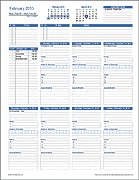SMART Goals Template
A SMART Goal is Specific, Measurable, Attainable, Relevant, and Time-bound. Our printable goal setting worksheet is designed to help you create and track your SMART goal, including a section for listing key steps and a log for monitoring your progress. You can download it for Excel, Google Sheets, or as an editable PDF. Continue reading below to learn more about goal setting and how to use the template.
SMART Goals Template
for Excel, Google Sheets, and PDFDownload
⤓ Excel (.xlsx)License: Private Use
(not for distribution or resale)
Authors: Jon Wittwer and Jim Wittwer
SPECIFIC
Your goals need to be clear and concise with a scope narrow enough to help you focus on what you need to do to achieve it. A short version of the goal may not be able to include all the details pertaining to S.M.A.R.T., but using this goal setting worksheet helps you include the extra details. Here are a few examples that include both the measure and the time frame.
- I will lose 20 lbs by Oct 10, 2021
- I will sign 5 new clients to increase sales by Feb 31, 2021
- I will increase the open rate of emails by 20% in the next 2 months.
- Our business will go paperless within 6 months.
You may want to include the primary purpose of the goal within the main description. In the above examples, this could be done by adding "so that [purpose]" to the end of each of the goals.
Here is a very generic template for creating a concise SMART goal:
Basic SMART goal template: I will [action] [measure] by [time] so that [purpose].
To help make your goal more specific and narrow the scope, ask yourself if you have adequately defined the Why, When, Where, Who, and How.
MEASURABLE
If your goal is measurable, then you not only have a way to know if you have achieved the end goal, but you can also track the progress by measuring along the way.
The MEASURE section at the bottom of the worksheet provides a place for you to keep a log of your progress. For a weight-loss goal, you can record your weight each week. For a business goal, you could record the number of new contacts, sales numbers, etc.
ATTAINABLE / ACHIEVEABLE
Identifying the challenges you may come across and the resources you'll need is an important part of goal setting. Take the time to fill in some of those details in the CHALLENGES section of the worksheet.
The KEY STEPS section is another useful tool for helping you create a plan to achieve your goal by breaking it down into smaller attainable steps. Some of these steps may be directly related to the challenges and resources that you mentioned.
For example, part of a weight loss goal might be to (1) purchase a bathroom scale, (2) sign up with a physical trainer at your favorite gym, (3) sign up for the pilates class, (4) download and begin using a health tracking app, etc.
If achieving your goal requires the development of new habits or routines, you may need to implement some type of tracking and accountability system beyond just occasionally measuring. Memory triggers can also be a big help. It is beyond the scope of this page to address the methods for developing good habits, but there are many books on the subject - "The Power of Habit" by Charles Duhigg is one I enjoyed.
Update 3/15/2021: Michael Hyatt has authored a book titled "Your Best Year Ever" in which he suggests different types of planning worksheets for Habit Goals vs. Achievement Goals. That book is definitely worth checking out.
RELEVANT
A goal is relevant when it has a definite beneficial purpose. So, this goal setting worksheet has a section for recording the PURPOSE of the goal. Why are you trying to achieve this goal? What are the benefits?
The purpose is often the main motivation for achieving the goal, so do not skip this part of the goal setting worksheet. The purpose is so important that you may want to include the primary purpose within the concise definition of the goal like I mentioned in the SPECIFIC section above.
TIME-BOUND
A goal is time-bound when it has a clear beginning and end. Defining a completion date is a very important step. It's human nature to postpone work, so if you don't have a specific deadline or completion date, you are much less likely to achieve your goal.
Try to use realistic data to help you in setting a goal date. Remember that your goal needs to be achievable. For example, losing 2-3 pounds per week may be achievable with a basic diet and exercise routine, so a goal to lose 20 pounds in 2 months may be a reasonable time frame.
Disclaimer
The content on this page is intended for educational purposes, and is based on the authors' experiences. There are other valid definitions for "SMART goal" and you are encouraged to do additional research on this topic.





